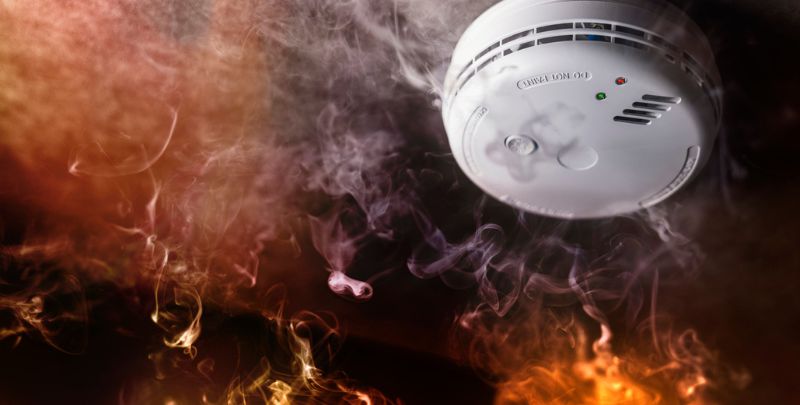
Smoke Alarms Essential to All Homes
Smoke alarms are now an essential – and compulsory – part of any household. The thought of waking up in a burning home and realising you and your family could be trapped is enough reason to install the best smoke alarms on the market.
But with changes to regulations and advances in technology, it can be confusing for householders when it comes to preparing for this most serious of potential home emergencies.
So, here we’ll explore everything you need to know about smoke alarms, from standards and regulations to the placement of units and different types on the market.
Are Smoke Alarms Mandatory?
Each state has different regulations but essentially every Australian home should have at least one working smoke alarm which complies with Australian Standards AS3786.
The statistics speak for themselves – a household without smoke alarms is 80% more likely to lose part or all of their home than those with a smoke alarm, and 50-80% more likely to suffer a fatality from a house fire.
These are enough reasons alone to install smoke alarms, but it is also part of the Building Code of Australia that all homes built and renovated since 1997 must have mains-powered smoke alarms with battery back-up installed.
Each state and territory has its own specific regulations:
- ACT – All homes built or renovated since 1997 must have at least one mains-powered alarm (photoelectric preferred).
- NSW – At least one alarm per level/apartment, mains-powered and interconnected recommended.
- NT – At least one photoelectric alarm, mains-powered or with a 10-year battery.
- Queensland – Interconnected photoelectric alarms that are mains-powered or have a 10-year battery (since 2017).
- SA – At least one alarm per home that is mains-powered or has a 10-year battery. New homes and extensions must have interconnected smoke alarms.
- Tasmania – At least one alarm per home, mains-powered or with a 10-year battery.
- Victoria – At least one working smoke alarm per home, photoelectric recommended.
- WA – At least one alarm per home that is mains-powered. Alarms with a 10-year battery are allowed when mains power is not possible.
Clearly working smoke alarms are mandatory in homes around the country, including rental properties. Wireless alarms are highly recommended. Most smoke alarms in residential properties are photoelectric alarms and comply with building code.
How Do Smoke Alarms Work?
There are two main types of smoke alarm used nationally, with some states and territories moving towards one particular type – photoelectric smoke alarms.
Let’s take a look at these two types of alarms and a couple of variations.
Photoelectric
Photoelectric smoke alarms use light and a photoelectric sensor to detect smoke. If smoke enters the chamber and crosses the path of light, the smoke particles scatter the light.
This can work in two different ways. One type directs light at a sensor and the scattering of light by smoke reduces the amount of light that reaches the sensor.
This will trigger the alarm. With the other type the light is not directed at a sensor. The scattering caused by smoke will cause light to reach a sensor which will trigger an alarm.
Most fire authorities recommend interconnected photoelectric smoke alarms. They have the best response to smouldering fires and are adequate with flame fires.
Ionisation
Ionisation smoke alarms are best at detecting flame fires. These alarms use two ionisation chambers and an electric circuit to detect fires. The alarms contain a small amount of radioactive material.
This ionises, or charges, the surrounding air, triggered by the ionisation sensor. Ionised air is positively and negatively charged and flows between two charged plates, also positively and negatively charged.
This creates a current. The first chamber is open to the air, while the second is enclosed and acts as a control reference. Both chambers have the same current.
When smoke is present in the first ionisation chamber, the ionised air attaches to some smoke particles. This disrupts the flow between the charged plates, which triggers the alarm.
Dual Sensor Detectors
Dual sensor smoke detectors combine both the ionisation and photoelectric methods of smoke detection. Some fire authorities recommend using dual sensor alarms as they cover a broader range of fires, making them safer than single sensor smoke alarms.
Heat Detectors
Rather than detecting the presence of smoke, heat detectors use temperature. When there is a fire, the heat rises to the alarm fixed to your ceiling. A heat detector contains a thermistor which detects temperature changes and triggers an alarm when it goes above a set temperature. It is not recommended to use only heat detectors, but rather to use them in spaces such as kitchens or garages.
If you’re considering getting a smoke alarm installed, consider interconnected alarms to give you the optimal level of fire protection.
Should Smoke Alarms Be Interconnected?
A smoke alarm is a standalone unit that detects smoke and sounds an alarm. Most smoke alarms can be hardwired to your electrical system.
But a smoke detector has units in various rooms with a single alarm system that interconnects them all.
Some Australian states now recommend you have alarms interconnected, if you have more than one unit. Wireless interconnected smoke alarms are highly recommended. However, smoke detector installation requires a licensed electrician.
Where Should Smoke Alarms Be Placed?
Alarms should be placed in the hallway or corridor connected to bedrooms. For levels that don’t have bedrooms, at least one fire alarm should be placed in the most likely evacuation path for the building. This is the recommended fire protection for most homes.
Smoke and steam are common in kitchens and bathrooms so smoke alarms should not be placed in these rooms. You don’t want to set off false alarms (aka nuisance alarms). Be warned that steam can set off a smoke alarm.
The centre of the ceiling is the best position for your smoke alarm. For cathedral ceilings, an alarm can be placed 500-1500mm from the apex. You can also install the alarm unit on your wall, 300-500mm below the ceiling.
How Often Should Smoke Alarms Be Changed?
A smoke alarm should be replaced every 10 years, as it deteriorates over time and becomes less sensitive. If your alarm is battery operated, batteries should be changed annually.
For basic smoke alarm maintenance, check your alarm every month to ensure it’s working. Most alarms have a test button for this purpose.
Give it a clean every six months with your vacuum cleaner to ensure no build-up of dust or debris affects its sensitivity.
In the case of fire or excessive smoke, call emergency services immediately.
In conclusion, make sure you follow your state’s regulations and, if you’re in a home without a smoke alarm and have smoke alarm questions, contact an expert immediately and arrange an appointment.
Please note: This information is provided for advice purposes only. Regulations differ from state to state, so please consult your local authorities or an industry professional before proceeding with any work. See our Terms & Conditions here.


